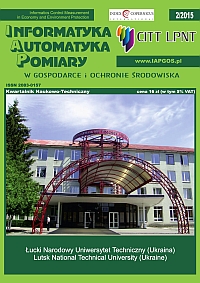PHOTOVOLTAIC SYSTEMS IN BUILDINGS – MODEL OF WORK IN LUBLIN CLIMATE CONDITIONS AND ENVIRONMENTAL ASPECTS
Article Sidebar
Open full text
Issue Vol. 5 No. 2 (2015)
-
SUPERVISION OF LABORATORY MEASURING EQUIPMENT BASED ON THE EXAMPLE OF ILLUMINANCE METERS
Agnieszka Banaszak, Justyna Wtorkiewicz3-5
-
FRACTAL GEOMETRIES IN LATERAL FLUX CAPACITOR DESIGN – EXPERIMENTAL RESULTS
Piotr Kocanda, Andrzej Kos, Adam Gołda6-9
-
EXPANSION OF THE DISCHARGE ARC IN THE AXIAL MAGNETICAL FIELD
Krzysztof Krasuski10-12
-
INNOVATIVE PROJECT OF MECHANISM FOR TOOLS LAPAROSCOPIC
Łukasz Mucha13-17
-
PREDICTIVE CURRENT CONTROLLER WITH MTPA CONTROL STRATEGY – SIMULATION RESULTS
Rafał Piotuch18-21
-
OPTIMIZATION OF 3D LOCAL ORIENTATION MAP CALCULATION IN THE MATLAB FRAMEWORK
Ranya Al Darwich, Laurent Babout22-24
-
TRACTION RECTIFIER-INVERTER SUBSTATION CONCEPT FOR 3 KV DC RAILWAY TRACTION SYSTEM
Włodzimierz Kruczek25-29
-
UTILIZATION IONEX FILE FOR POSITIONING CORRECTION OVER RYKI DISTRICT AREA
Kamil Krasuski30-34
-
UTILISATION OF ÅNGSTRÖM METHOD FOR ESTIMATING A THERMAL DIFFUSIVITY OF CHARGE IN INDUCTION HEATING SETUP
Adam Cieślak, Jerzy Zgraja35-38
-
METHODS OF EEG ARTIFACTS ELIMINATION
Małgorzata Plechawska-Wójcik39-46
-
ELECTRICAL PROPERTIES OF (FeCoZr)x(Al2O3)(100-x) NANOCOMPOSITES PRODUCED BY SPUTTERING OF ARGON AND OXYGEN BEAM AS CAPACITOR SYSTEMS
Konrad Kierczyński, Tomasz Kołtunowicz47-54
-
EYE-TRACKING IN DIAGNOSIS OF NEURODEGENERATIVE DISEASE
Magdalena Borys55-63
-
PHOTOVOLTAIC SYSTEMS IN BUILDINGS – MODEL OF WORK IN LUBLIN CLIMATE CONDITIONS AND ENVIRONMENTAL ASPECTS
Agnieszka Żelazna64-71
-
AUTOMATION OF ROAD TRAIN MOTION IN REVERSE
Pavlo Gumenyuk72-80
-
Mapa rozwoju dyscypliny Elektrotechnika
Tadeusz Citko81-93
Archives
-
Vol. 7 No. 4
2017-12-21 23
-
Vol. 7 No. 3
2017-09-30 24
-
Vol. 7 No. 2
2017-06-30 27
-
Vol. 7 No. 1
2017-03-03 33
-
Vol. 6 No. 4
2016-12-22 16
-
Vol. 6 No. 3
2016-08-08 18
-
Vol. 6 No. 2
2016-05-10 16
-
Vol. 6 No. 1
2016-02-04 16
-
Vol. 5 No. 4
2015-10-28 19
-
Vol. 5 No. 3
2015-09-02 17
-
Vol. 5 No. 2
2015-06-30 15
-
Vol. 5 No. 1
2015-03-31 18
-
Vol. 4 No. 4
2014-12-09 29
-
Vol. 4 No. 3
2014-09-26 22
-
Vol. 4 No. 2
2014-06-18 21
-
Vol. 4 No. 1
2014-03-12 19
-
Vol. 3 No. 4
2013-12-27 20
-
Vol. 3 No. 3
2013-07-24 13
-
Vol. 3 No. 2
2013-05-16 9
-
Vol. 3 No. 1
2013-02-14 11
Main Article Content
DOI
Authors
Abstract
Due to the increasing consumption and depletion of fossil fuels’ resources, one of the nowadays major problems is energy supply. Consequently, renewable energy sources, such as solar energy, are becoming more and more popular. However, introduction of new technologies should always be accompanied by the analysis of their impact on the environment. This article presents the results of the comparison of carbon dioxide emissions from selected photovoltaic systems on the basis of the environmental management method Life Cycle Assessment. Model of the installation work included local climate conditions. In comparison with the emission indicators of conventional energy sources, solar technologies bring a significant decrease of greenhouse gas emissions throughout the life cycle, and therefore can be used for the implementation of the international regulations in this area.
Keywords:
References
Adamczyk J.: Koncepcja zrównoważonego rozwoju w zarządzaniu przedsiębiorstwem, Wydawnictwo Akademii Ekonomicznej w Krakowie, Kraków 2006.
Alsema E.A.: Energy Pay-back Time and CO2 emissions of PV systems. Progress in Photovoltaics: Research and Applications, Vol. 8, I. 1, 2000, 17-25.
Ardente F., Beccali G., Cellura M., Lo Brano V.: Life cycle assessment of solar thermal collector. Renewable Energy, Vol. 30, 2005, 1031-1054.
Battisti R.G, Corrado A.: Environmental assessment of solar thermal collectors with integrated water storage. Journal of Cleaner Production, Vol. 13, 2005, 1295-1300.
Cel W., Pawłowski A., Cholewa T.: Ślad węglowy jako miara zrównoważoności odnawialnych źródeł energii / Carbon footprint as the sustainability indicator for renewable energy sources. Prace Komisji Ekologii i Ochrony Środowiska Bydgoskiego Towarzystwa Naukowego, Vol. IV, 2010, 15-22.
Frankl P., Corrado A., Lombardelli S.: Photovoltaic (PV) systems, final report ECLIPSE. European Commission 2004.
Fthenakis V.M.: Life Cycle Impact analysis of cadmium in CdTe PV production. Renevable & Sustainable Energy Review, Vol. 8, 2004, 303-334.
Fthenakis V.M., Kim H.C., Alsema E.: Emissions from Photovoltaic Life Cycles. Environmental Science Technology, Vol. 42, 2008, 2168-2174.
Kalogirou S.: Environmental benefits of domestic solar energy systems. Energy Conversion and Management, Vol. 45, 2004, 3075-3092.
Kalogirou S.: Thermal performance, economic and environment al life cycle analysis of thermosiphon solar water heaters. Solar Energy, Vol. 83, 2009, 39-48.
Kowalski Z., Kulczycka J., Góralczyk M.: Ekologiczna ocena cyklu życia procesów wytwórczych (LCA)/Ecological Life Cycle Assessment of manufacturing processes (LCA), PWN, 2007.
Pawłowski A.: Rewolucja rozwoju zrównoważonego. Problemy Ekorozwoju/Problems of Sustainable Development, Vol. 4, No 1, 2009, 65-76.
Popczyk J.: Ocena potencjału realizacji celów Pakietu 3x20, w szczególności w aspekcie redukcji emisji za pomocą różnych technologii. Zmiany klimatu – wyzwania dla gospodarki, Vol. 4, 2009, http://csm.org.pl/
www.jrc.ec.europa.eu, Joint Research Centre, 01.2015.
Zbiciński I., Staveniuter J., Kozłowska B., Van De Covering H.P.M.: Product Design and Life Cycle Assessment, Book 3 in a series on Environmental Management, The Baltic University Press, Uppsala 2006.
Zdyb A.: Badania nad zwiększeniem wydajności barwnikowych ogniw słonecznych. Monografie PAN, Vol. 94, Lublin, 2012.
Żelazna A., Pawłowski A.: Korzyści środowiskowe z wykorzystania systemów solarnych na przykładzie budynku jednorodzinnego, Proceedings of ECOpole, Vol. 5(2), 2011, 649.
Article Details
Abstract views: 269
License

This work is licensed under a Creative Commons Attribution-ShareAlike 4.0 International License.






